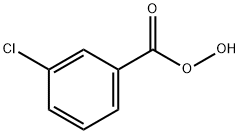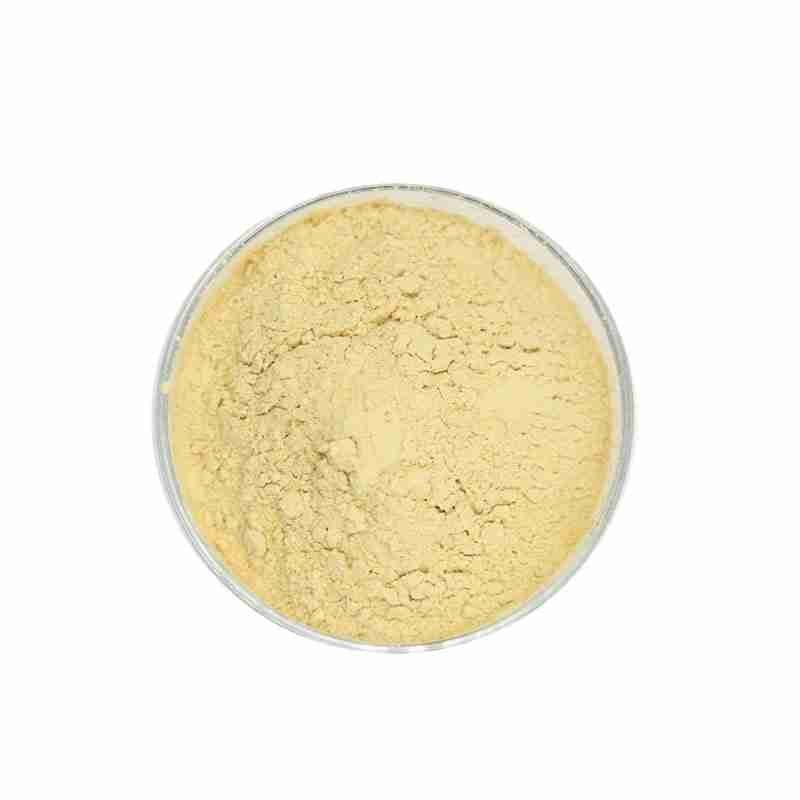3-Chloroperoxybenzoic Acid CAS# 937-14-4
3-Chloroperoxybenzoic acid (m-CPBA) is a carboxylic acid derivative, a white powder crystal, almost insoluble in water, conveniently soluble in ethanol, ether, soluble in chloroform, dichloroethane. Steady to warm, the annual disintegration price is listed below 1% at room temperature level. Disintegration rate is accelerated in liquid state.
In a polyethylene container, include 1.5 g of magnesium sulfate heptahydrate, 36g of sodium hydroxide, 360ml of water, 90ml of 30% hydrogen peroxide, 450ml of dioxane as well as ice cubes, reduced the temperature level to 15 ?? C, as well as include 52.5 g of M-chlorobenzoyl chloride, after that include ice to keep the temperature level listed below 25 ?? C. After reacting for 15 mins, include 900ml of 20% chilly sulfuric acid. After standing still, the organic layer was divided, filteringed system, and the filtrate was evaporated to eliminate the solvent (high vacuum cleaner distillation) to get 51g of 3-chloroperbenzoic acid.
发送询盘
3-Chloroperoxybenzoic Acid CAS# 937-14-4
| 3-Chloroperoxybenzoic acid Basic information |
| Chemical Properties?Uses |
| Product Name: | 3-Chloroperoxybenzoic acid |
| Synonyms: | 3-CHLOROPEROXYBENZOIC ACID;3-Chloroperoxy benzoic acid(more than 57% but not more than 86%,with 3-chorobenzoic acid);3-Chloroperoxybenzoic acid, balance 3-Chlorobenzoic acid and water, 70-75%;3-Chloroperoxybenzoic acid, 70 – 75%, (balance 3-chlorobenzoic acid and water);3-Chlorobenzeneperoxycarboxylic acid;3-Chloroperoxybenzoic Acid (contains min. 17% Water and min. 6% 3-Chlorobenzoic Acid);3-Chloroperoxybenzoic Acid (contains ca. 30% Water);3-Chloroperoxybenzoic acid ,75% |
| CAS: | 937-14-4 |
| MF: | C7H5ClO3 |
| MW: | 172.57 |
| EINECS: | 213-322-3 |
| Product Categories: | Organic Peroxide;Oxidation;Synthetic Organic Chemistry;Organic acids;PHARMACEUTICAL INTERMEDIATES;Aromatics;bc0001;top |
| Mol File: | 937-14-4.mol |
 |
|
| 3-Chloroperoxybenzoic acid Chemical Properties |
| Melting point | 69-71???C(lit.) |
| Boiling point | 244.67??C (rough estimate) |
| density | 0.56 |
| vapor pressure | 0.373Pa at 25?? |
| refractive index | 1.4580 (estimate) |
| storage temp. | 2-8??C |
| solubility | Chloroform (Slightly), Ethyl Acetate (Slightly), Methanol (Slightly) |
| pka | 7.57 (in water @ 25 ??C) |
| form | Moist Powder |
| color | White |
| PH | 4.5@25 ??C (saturated aq. sol) |
| Odor | slight pungent odor |
| Water Solubility | insoluble |
| Decomposition | >88 ??C |
| BRN | 608317 |
| Stability: | Strong oxidizing agent – contact with combustible material may cause fire. May be shock or heat sensitive. Incompatible with organic materials, strong reducing agents. |
| InChIKey | NHQDETIJWKXCTC-UHFFFAOYSA-N |
| LogP | 1.03 at 25?? |
| CAS DataBase Reference | 937-14-4(CAS DataBase Reference) |
| NIST Chemistry Reference | 3-Chloroperbenzoic acid(937-14-4) |
| EPA Substance Registry System | Benzenecarboperoxoic acid, 3-chloro- (937-14-4) |
- 2
- 2-diallylpent-4-en-1-amine
- 4
- 95-16-9
- Ammonium sulfamate
- Benzothiazole
- cas:67889-00-3ح2
- cas:83524-75-8 | pigment black 32
- cas:928836-00-4 | 2
- cas:932745-70-5 | 4
- Chemical Minerals
- Coconut diethanolamide
- Daily Chemicals
- discount
- for sale
- General pvc resin
- hexyl D-glucoside
- in stock
- Lauramidopropyl betaine
- LAURIC ACID MONOETHANOLAMIDE
- Petroleum Additives
- Plasticiser
- Ploymers
- price
- PVC
- quotation
- Raw Materal
- Remove term: Petroleum Additives Petroleum Additive
- SODIUM ETHYL 2-SULFOLAURATE
Related Products
Octocrylene is an organic compound widely recognized for its potent UV-filtering properties, making it an essential ingredient in sunscreens and other skincare products designed to protect the skin from harmful ultraviolet radiation. With the chemical name 2-(4-Methylbenzyl)-2H-benzotriazole-5-methyl, octocrylene is a stable and photostable molecule that provides broad-spectrum protection against both UVA and UVB rays.
This oil-soluble chemical is valued for its ability to absorb UV radiation effectively, converting it into heat without causing skin irritation or staining clothes. Octocrylene is often used in combination with other UV filters to enhance the sun protection factor (SPF) of formulations, ensuring a balanced and comprehensive defense against sun damage.
As a lipophilic compound, octocrylene is compatible with various cosmetic and dermatological formulations, contributing to the development of lightweight, non-greasy sunscreens. Its chemical structure allows for a high degree of safety and efficacy, making it suitable for a wide range of skin types, including sensitive skin.
In summary, octocrylene is a reliable and efficient UV filter, pivotal in the formulation of modern sunscreens that offer advanced protection against the sun’s harmful effects while maintaining skin comfort and product aesthetics.
Octyl 4-methoxycinnamate, scientifically known as 2-Ethylhexyl 4-Methoxycinnamate, is a highly effective organic UV filter commonly used in the formulation of sunscreens and cosmetic products. This compound is renowned for its ability to absorb ultraviolet B (UVB) radiation, providing a reliable defense against the sun’s harmful effects on the skin.
Characterized by its chemical formula C19H28O3, Octyl 4-methoxycinnamate is a liquid ester that is readily soluble in organic solvents. It is valued for its photostability, which means it maintains its protective properties even after prolonged exposure to sunlight. This feature makes it an ideal ingredient for products designed to offer long-lasting sun protection.
In addition to its UVB absorption capabilities, Octyl 4-methoxycinnamate is also appreciated for its compatibility with other UV filters, allowing for the creation of broad-spectrum sunscreens. It contributes to the development of formulations that are non-greasy and cosmetically elegant, suitable for a variety of skin types.
As a key component in sun care products, Octyl 4-methoxycinnamate supports the skin’s health by preventing sunburn, reducing the risk of skin cancer, and delaying the signs of photoaging. Its safety profile and efficacy make it a preferred choice in the personal care and dermatological industries for sun protection solutions.
Chemical Name: Quercetin-3-O-sophoroside
CAS No.: 18609-17-1
Molecular Formula: C27H30O17
Molecular Weight: 626.52
Chemical Name: UV-120
Other Name: (2’,4’-Di-tert-butylphenyl 3,5-di-tert-butyl-4-hydroxybenzoate)
CAS No.: 4221-80-1
Molecular Fomula: C29H42O3
Molecular weight: 438.66
Assay: ≥99%(LC)
Ethylhexyl Palmitate is a skin-conditioning ester, derived from ethylhexanol and palmitic acid, that imparts moisturization and a smooth texture to cosmetic and personal care formulations. It is valued for its emollient properties, enhancing the sensory experience of skin care products.
3,4-Ethylenedioxythiophene is a synthetic organic compound characterized by its unique structure that includes a thiophene ring with ethylenedioxy substituents at the 3 and 4 positions. This compound is known for its potential applications in the synthesis of various organic materials, including pharmaceuticals and organic electronic devices such as sensors and solar cells. Its stability and reactivity make it a versatile intermediate in the chemical industry.
Common English name: 5-iodo-2,3-dihydropyridazin-3-one
CAS No.: 825633-94-1
Molecular formula: C4H3IN2O
Molecular weight: 221.98
Sample: Available
Succinimide is a heterocyclic organic compound and an important industrial chemical. It serves as a key intermediate in the synthesis of various pharmaceuticals, agrochemicals, and other specialty chemicals. Known for its reactivity and versatility, succinimide is widely used in the production of succinic anhydride, a precursor to many polymers and plasticizers, highlighting its significance in the chemical industry.
Chemical Name: 1,1,2,2-Tetrachloroethane
Other Name: Tetrachlorethane
CAS No.: 79-34-5
Molecular Formula: C2H2Cl4
Molecular Weight: 167.85
Appearance: Liquid
Silicones are a family of synthetic polymers known for their versatility and stability. They are heat-resistant, non-toxic, and have excellent electrical insulation properties. Commonly used in various industries such as construction, automotive, aerospace, and personal care products, silicones offer a wide range of applications from sealants and adhesives to lubricants and medical devices. Their resistance to extreme temperatures and weathering makes them a preferred choice for many high-performance applications.
Chemical Name: Choline salicylate
CAS No.: 2016-36-6
Molecular Formula: C12H19NO4
Molecular Weight: 241.28
Appearance: Red-Brown Crystal
Chemical Name: Ashwagandha Extract
Synonyms: Withania somnifera, ext.; Withania Somnefera Extract
CAS: 90147-43-6
Appearance: Brown



















